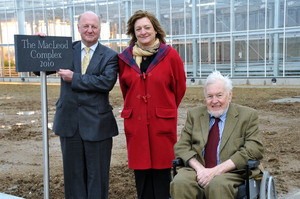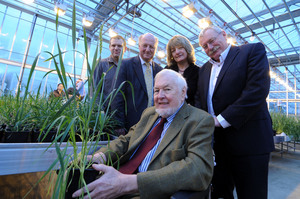The National Institute of Agricultural Botany (NIAB) has opened a state-of-the-art glasshouse facility at its Park Farm site near Histon in Cambridge. The development, which incorporates the latest greenhouse technology and biomass heating, replaces older glasshouses due for demolition at the main NIAB site on Huntingdon Road.
Named The MacLeod Complex after Professor John MacLeod, former NIAB Director and now chairman of the NIAB Trust, the new facility is part of a significant programme of investment by NIAB to update and extend the Institute’s facilities for plant science, variety evaluation and seed testing.
The Bingham Laboratory, named after pioneering plant breeder John Bingham, was opened in 2008 to support NIAB’s expanding role in plant genetics and pre-commercial plant breeding, and new growth room facilities were opened at the Huntingdon site in 2009 to strengthen the Institute’s leading edge services in pathology and micropropagation.
“With mounting concerns over food security and climate change, NIAB is positioning itself for a future where the importance of plant genetics will undoubtedly increase,” said NIAB chief executive Dr Tina Barsby.
“Our aim is to bring together within a unique resource the specialist knowledge, skills and facilities needed to support the development of improved crop varieties, to evaluate their performance and quality, and to ensure the benefits of those advances are transferred effectively onto UK farms. This investment marks a further step towards that objective.”
The MacLeod Complex was officially opened by James Paice, MP for South East Cambridgeshire and Shadow Farming Minister on Friday (27th January). Mr Paice said:
“NIAB is renowned internationally for its expertise in seed and variety testing, and this impressive new glasshouse facility will help strengthen the Institute’s core activities in those areas. I’m also delighted that NIAB is extending its research capabilities to strengthen the link between the genetic improvement of crops and their delivery into practical agriculture. Such developments will be vital if UK agriculture is to play its part in meeting the challenge of increasing yields while reducing environmental impact.”
Explaining the hi-tech equipment used in the new facility, NIAB’s operations director Dr John Hutchins said:
“The technology installed in each of the eight new glasshouses varies allows different environmental conditions to be created to suit the diverse range of plant material NIAB works with. This technology includes thermal roof shades, blackout screens, night break lighting, automatic irrigation, as well as supplementary lighting of different types and intensities.
“An on-site weather station connected to the glasshouse climate control system automatically regulates the glasshouse temperatures. Space is also used more efficiently than in the older glasshouses so our overall crop growing space is far greater. A wood-pellet fired biomass boiler, grant-aided by the Department of Energy and Climate Change under the Bio-energy Capital Grants Scheme, provides around 50% of the heating requirements, and helps minimise the carbon footprint of the new installation,” said Dr Hutchins.


For further information contact:
Dr John Hutchins, operations director, NIAB
T: 01223 342262
E: john.hutchins [at] niab.com ()
Issued by:
Ros Lloyd, Front Foot Communications
T: 01487 831425
E: ros.lloyd [at] frontfoot.uk.com ()
